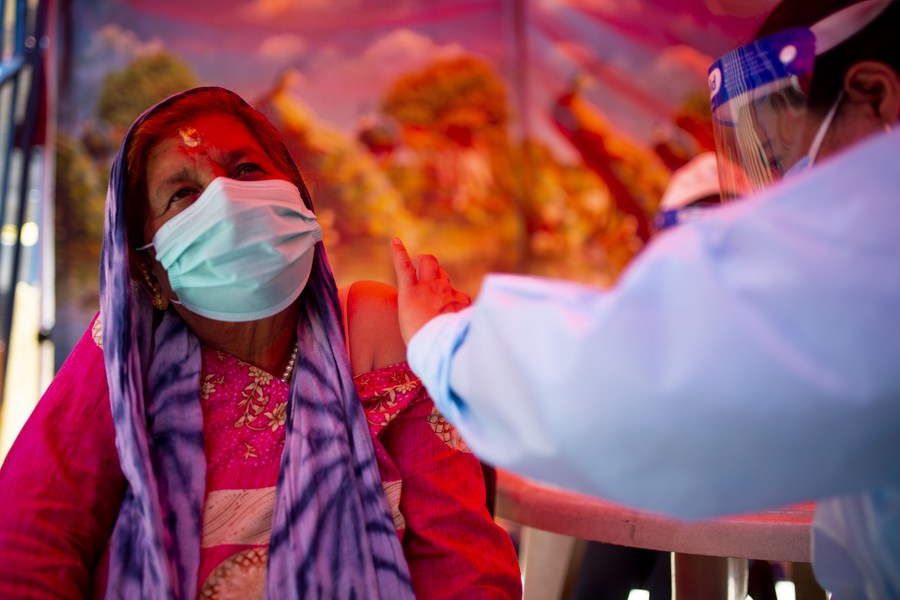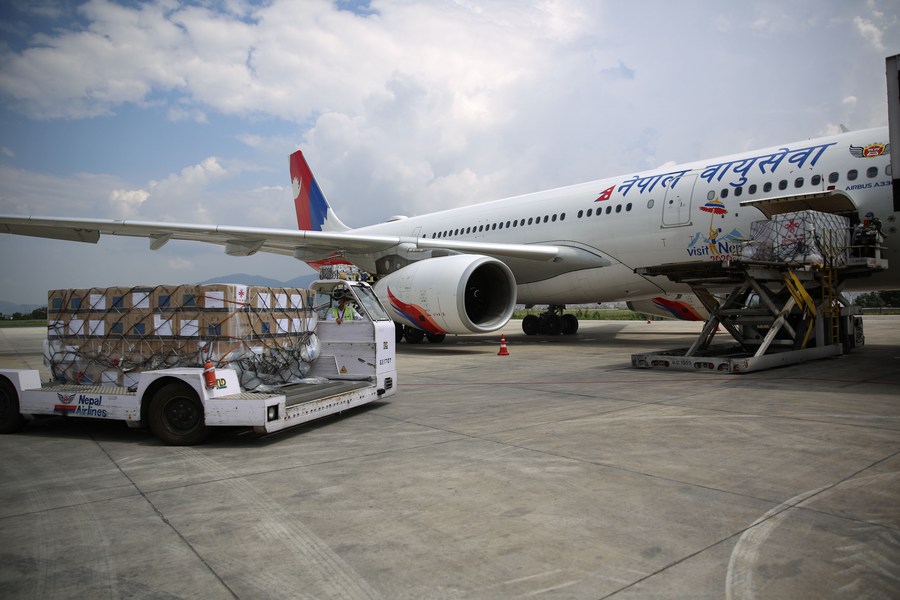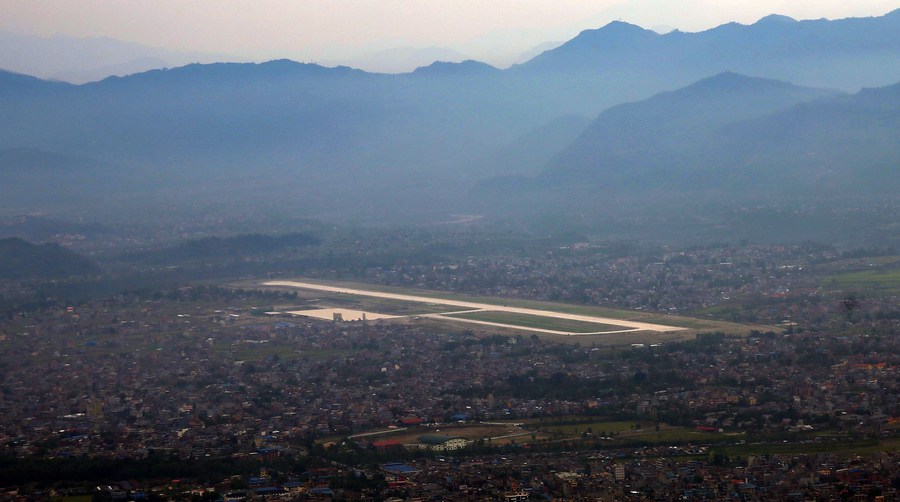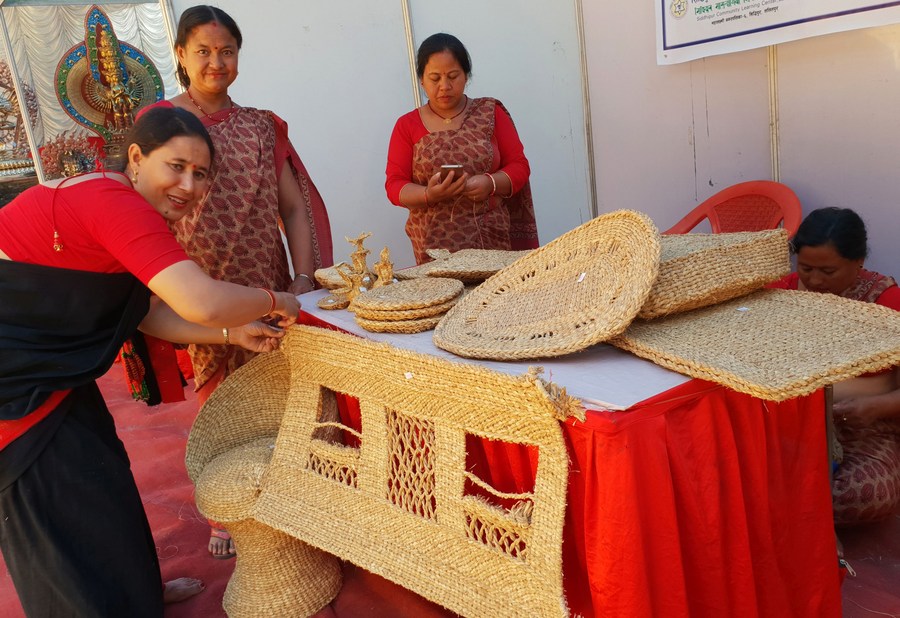
People from Kirat community celebrate Udhauli Festival in Lalitpur, Nepal on Dec. 19, 2021. (Photo by Sulav Shrestha/Xinhua)
Nepal and China have been working together in infrastructure construction, as well as trade and investment amid the pandemic.
KATHMANDU, Dec. 23 (Xinhua) -- Nepal and China have been continuing cooperation in 2021 as the COVID-19 pandemic lingers unabated, and making progress in particular in areas including vaccines, infrastructure building, investment and trade.
Nepal's pandemic-hit tourism sector is eager to see Chinese tourists return as early as possible.

A woman receives a dose of COVID-19 vaccine in Kathmandu, Nepal, June 8, 2021. (Xinhua/Sulav Shrestha)
SWIFT DELIVERY OF VACCINE DOSES
Since the first 800,000 jabs of Sinopharm COVID-19 vaccine donated by China arrived in Nepal on March 29, the South Asian country has so far received 13.8 million doses of Chinese vaccines in total, either granted or procured from the northern neighbor, according to the Nepali Ministry of Health and Population.
Yet to arrive are an extra 3 million shots donated by China, while some of the 5.9 million Chinese doses procured by Nepal from the COVAX facility with a loan from the Asian Development Bank have been delivered.
The Chinese-made vaccine tops the list of the 35.4 million doses of COVID-19 vaccines already sent to Nepal, according to Sagar Dahal, chief of Nepal's National Immunization Program.
"Particularly, the contribution of the Chinese vaccine in taking the country out of the second wave of COVID-19 has remained crucial, because we received Chinese vaccine shots early and in the largest quantity," said Dahal.

A batch of Chinese vaccine arrives in Kathmandu, Nepal on June 1, 2021. (Xinhua/Sulav Shrestha)
Nepali experts echoed, saying the country received Chinese vaccine jabs in large quantities at a time when the country was fighting a desperate battle against a resurgent virus.
Besides vaccine jabs, Nepal had also received a large quantity of oxygen cylinders, concentrators and other medical equipment from China at the peak of the second wave of the epidemic.
"Without Chinese support to the vaccination drive and the supply of medical equipment, it would be very difficult for us to come out of the second wave of the pandemic," said Govinda Nepal, a senior economist. "The Chinese support has also remained crucial to saving the economy from heading toward disasters."

Aerial photo taken on June 4, 2019 shows the newly constructed runway of Pokhara Regional International Airport in Pokhara, Nepal. (Xinhua/Sunil Sharma)
AIRPORT CONSTRUCTION CONTINUES
As the coronavirus surges, Nepal-China cooperation on infrastructure cannot be spared from the ravages either.
The construction of Pokhara International Airport with Chinese assistance in the western city of Pokhara was supposed to be completed in July this year, but the Nepali government had to extend the deadline, since the lockdowns imposed to curb the virus had affected the procurement of materials and supplies and the mobilization of workers for the project.
"Despite the delay in completion of the project, the works related to physical infrastructure have almost been completed and the installation of equipment including radar is going on currently," said Deo Chandra Lal Karn, spokesperson for the Civil Aviation Authority of Nepal. "It will be completed next year and it will emerge as a milestone in bilateral economic cooperation between Nepal and China."
Likewise, the proposed detailed feasibility study of a cross-border railway project has been delayed due to COVID-19, according to Aman Chitrakar, spokesperson for Nepal's Department of Railways.
In his video message to the International Conference on Nepal's Reconstruction 2021 held on Dec. 7, Chinese State Councilor and Foreign Minister Wang Yi said, "China will make solid progress in the feasibility study of a cross-border railway project, improve the Trans-Himalayan Multi-dimensional Connectivity Network, and help Nepal realize its dream of changing from a 'land-locked country' to a 'land-linked country.'"

People are seen at a gold shop reopened after the local government relaxed its prohibitory orders in Kathmandu, Nepal, on June 22, 2021. (Xinhua/Sulav Shrestha)
COMMITTED CHINESE INVESTMENTS GROWING
Despite continued uncertainty sparked by the pandemic, Chinese investors are showing greater interest in the Nepali market.
In the 2020-21 fiscal year that ended in mid-July, China topped the chart by committing the highest amount of foreign direct investment (FDI) to Nepal for six years in a row.
Chinese investors pledged 22.5 billion Nepali rupees (184.8 million U.S. dollars) in FDI in 2020-21, nearly 70 percent of the total 32.17 billion rupees (264.24 million dollars) committed by foreign investors, according to the Nepali Department of Industry.
In the first five months of the current 2021-22 fiscal year, Chinese investors had already committed as much as 23.15 billion rupees (190.16 million dollars) in investments in Nepal, more than the entire 2020-21 fiscal year.
The investments pledged by the Chinese investors go to hotels and restaurants, international cargo handling, mask manufacturing, construction service, software development, packaged drinking water, the assembling of electric vehicles and furniture, among others.
"We have been receiving good investments in the hydropower and cement industries from China in recent years," said Shiva Ratna Sharda, director at Hongshi Shivam Cement, a Nepal-China joint venture. "But the pandemic forced many Chinese restaurants to close down."

Nepali exhibitors arrange their handicraft works at the Nepal-China Expo 2018 in Lalitpur district, Nepal, on Oct. 5, 2018. (Xinhua/Sunil Sharma)
TRADE REMAINS STRONG
The Nepal-China trade remained strong in 2020-21 and the first four months of 2021-22 amid COVID-19, as shown by Nepal Rastra Bank figures.
In 2020-21, Nepal imported goods worth 233.92 billion rupees (1.92 billion dollars) from China, while during the first four months of 2021-22, the volume stood at 94.3 billion rupees (774.48 million dollars).
During the periods, Nepal's exports to its northern neighbor were worth 1 billion rupees (8.34 million dollars) and 311 million rupees (2.57 million U.S. dollars) respectively.
"Despite a healthy trade growth amid the challenges, it is necessary to address this trade imbalance," said Nepal, the economist.
Nepali traders have complained about difficulty in importing goods from China through the land routes.
"Due to the coronavirus risk, limited quantities of goods are being cleared from the border points," said Ashok Kumar Shrestha, president of Nepal Trans Himalaya Border Commerce Association. "Poor infrastructure on the Nepal side of the border is also hindering any efforts to increase shipments."

Photo taken on May 16, 2020 shows the scenery of Mount Qomolangma at sunset. (Xinhua/Purbu Zhaxi)
Braving the coronavirus and all the restrictions, 5,556 Chinese tourists visited Nepal by October this year, according to the Nepal Tourism Board.
In contrast, Nepal welcomed 169,543 Chinese tourists in 2019, when China once again became the second largest source of visitors to the country.
"The emergence of the new Omicron variant of the coronavirus has dashed our hope of welcoming Chinese tourists at least in early 2022," said Kishor Raj Pandey, chairperson of Sathi Travels.
"Based on my conversations with Chinese friends, it may take until the end of 2022, when the situation will improve, to bring Chinese tourists to Nepal." ■



